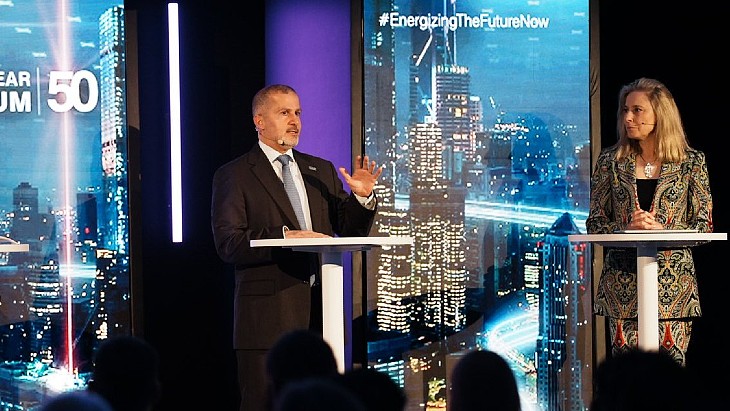According to a White House statement, the Summit on Domestic Nuclear Deployment on 29 May was held to highlight "the collective progress being made from across the public and private sectors". It drew attention to actions taken by the current Administration to reduce reliance on Russian uranium for civil nuclear fuel, and build the nuclear fuel supply chain, the multi-country declaration at COP28 to triple nuclear energy capacity globally by 2050 as well as work on developing new reactor designs and extending the service lives of existing nuclear reactors and growing the momentum behind new deployments.
"Recognising the importance of both the existing US nuclear fleet and continued build out of large nuclear power plants, the US is also taking steps to mitigate project risks associated with large nuclear builds and position US industry to support an aggressive deployment target," the White House said.
The Nuclear Power Project Management and Delivery working group announced by the Administration will draw on "leading experts from across the nuclear and megaproject construction industry" to help identify opportunities to proactively mitigate sources of cost and schedule overrun risk, the White House said. Working group members will come from federal government entities, including the White House Office of Domestic Climate Policy, the White House Office of Clean Energy Innovation & Implementation, the White House Office of Science and Technology Policy, and the Department of Energy (DOE). It will engage stakeholders including project developers, engineering, procurement and construction firms, utilities, investors, labour organisations, academics, and NGOs, "which will each offer individual views on how to help further the Administration’s goal of delivering an efficient and cost-effective deployment of clean, reliable nuclear energy and ensuring that learnings translate to cost savings for future construction and deployment".
Military reactor deployment
Small modular reactors (SMRs) and microreactors can provide defence installations with energy that is resilient to challenges such as physical or cyberattacks, extreme weather, or pandemic biothreats that can disrupt commercial energy networks. The US Army is exploring the deployment of advanced reactors to help meet its energy needs and "will soon release a Request for Information to inform a deployment programme for advanced reactors to power multiple Army sites in the United States", the White House said.
The Army's effort - alongside two current defence reactor programmes, the Department of the Air Force microreactor pathfinder at Eielson Air Force Base in Alaska, and the Office of the Secretary of Defense Strategic Capabilities Office Project Pele prototype transportable microreactor project - "will help inform the regulatory and supply chain pathways that will pave the path for additional deployments of advanced nuclear technology to provide clean, reliable energy for federal installations and other critical infrastructure".
Taking action
The White House also highlighted the release by the DOE of a new primer highlighting the expected enhanced safety of advanced nuclear reactors including passive core cooling capabilities and advanced fuel designs, and the release by Idaho National Laboratory of a new advanced nuclear reactor capital cost reduction pathway tool to help developers and stakeholders to assess cost drivers for new projects.
The US Administration said it "notes the completion" of Vogtle units 3 and 4 - the first new reactors built in the USA in more than 30 years, which it said had been made possible by DOE financing and support, including loan guarantees for the construction of the units. It said the government "will continue to take action to enable first movers to deploy advanced and innovative technologies" building on actions that have already been taken. These include steps to "revive and revitalise" existing nuclear, such as a USD1.5 billion conditional loan commitment to support Holtec Palisades' efforts to restart the Palisades nuclear power plant in Michigan, the DOE's Civil Nuclear Credit programme which is helping to fund the life extension of the Diablo Canyon plant in California, and the production tax credit under the Inflation Reduction Act which is supporting the continued operation of existing nuclear power plants.
The White House also highlighted steps it is taking to support the demonstration and deployment of new nuclear technologies, including the DOE’s Advanced Reactor Demonstration Program, and a Congressional appropriations package providing USD800 million to fund up to two Gen III+ SMR demonstration projects, the implementation of which is to be announced later this year. It also highlighted the work that being done by the US Nuclear Regulatory Commission to streamline the licensing process for building new reactors and life extensions and capacity expansions of existing reactors, and initiatives to develop the nuclear supply chai and workforce, including the recently signed Prohibiting Russian Uranium Imports Act.
"Taken together, these actions represent the largest sustained push to accelerate civil nuclear deployment in the United States in nearly five decades," the White House said.

.jpg)



_18570.jpg)
_16159.jpg)
_18938.jpg)
_33584.jpg)





